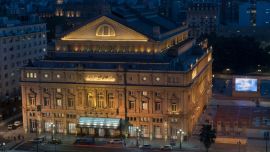There can be little doubt that Argentina’s Judiciary is absolutely rotten to the core. The recent explosion of the extortion case against supposed lawyer and self-proclaimed Drug Enforcement Agency (DEA) agent, Marcelo D’Alessio, has exposed a rift between different actors that respond to various sectors including judges, prosecutors, lawyers, members of domestic and foreign intelligence agencies, politicians, and, yes, journalists. Yet, there appears to be a certain reticence among some in the profession to report on their colleagues, while in others an inner flame heats up as they tear disgraced journalists to pieces. Neither one nor the other should be acceptable among journalists who have a sort of Hippocratic oath with the reader to tell the truth, yet it seems that journalism, like so many other institutions in this country, has also suffered from chronic decadence.
The extraordinary case against D’Alessio, which ropes in federal prosecutor Carlos Stornelli — the man in charge of leading the biggest corruption case in Argentine history, aptly known as the “corruption notebooks” scandal — effectively blew up like a grenade, shrapnel flying out in every direction. This week, federal judge Alejo Ramos Padilla, of the Buenos Aires province city of Dolores, formally accused D’Alessio of belonging to an illicit association that engaged in illegal investigations with the intention of forcing testimony in key judicial investigations, economic gain, and extortion. Ramos Padilla’s argument was based on evidence presented by agri-businessman Pedro Etchebest, who claimed D’Alessio attempted to extort him to the tune of US$300,000 in order to get him off the hook in the ‘cuadernos’ case, supposedly on behalf of Stornelli. The prosecutor has denied any involvement.
Working against the clock, judge Ramos Padilla searched D’Alessio’s properties — only to find numerous luxury vehicles and motorcycles, equipment for intelligence operations, and high-calibre weapons — then remanded him in custody. His phones were searched only after he was pressured to unlock his iPhone, which uses facial recognition technology, unveiling what the judge called an “incestuous” relationship with Stornelli’s office. Ramos Padilla knew there’s a big chance he may see the case moved to Comodoro Py federal courthouse on jurisdictional issues, so he quickly indicted D’Alessio and tacitly pointed to several others including Stornelli, former police inspectors Ricardo Bogoliuk and Aníbal Degastaldi, and a group of journalists including Clarín’s Daniel Santoro. By Friday, Santoro had dropped off of primetime TV show Animales Sueltos and Stornelli had sent his lawyer to the Dolores courthouse to request that the case be transferred to Buenos Aires. Santoro wasn’t the only one mentioned: Eduardo Feinmann and Rolando Graña (who both work for America 24 TV channel, owned by the same company that airs Animales Sueltos), and Rodrigo Alegre (TV journalist for Grupo Clarín’s different stations) were also mentioned. All of them have denied involvement.
Santoro, though, is in the hot seat. Clarín’s leading investigative journalist is revealed as the man who introduced D’Alessio to Stornelli. He also appears in pictures with D’Alessio, their wives and a few friends wearing Soviet Union military hats, a sort of inside joke as their wives are Russian and German, respectively, and the journalist has been said to have worked with Russian intelligence agencies, even though this is nothing more than a rumour. At the same time, D’Alessio brags of his friendship with Santoro and shows Etchebest, as he’s attempting to scare him, how he uses contacts to force a plea bargain in a separate case between a former executive of Venezuelan state oil firm PDVSA and prosecutor Stornelli, which is later covered by Santoro. D’Alessio, filming with his phone, was present both times.
Interestingly, only Perfil published a story naming the journalists who appeared in judge Ramos Padilla’s indictment and that were connected, consciously or not, with the case that threatens to unravel how one of the darkest parts of Argentina’s legal system works. Furthermore, after publishing a series of stories on the issue, several journalists and media executives blasted us for doing so, even internally. It seems like publishing news about those who make the news unsettled the ecosystem at a time of instability, with a polarised electorate during an electoral year.
Journalism about journalists is difficult as not only does it imply covering peers and colleagues, but it requires taking a step back and understanding the complexities and risks of making the news in a broader context. It should be painfully clear by now that media outlets have manipulated the public opinion for more than a century, even though today we are more concerned about fake news distributed on social media. In the same way as journalism considers itself the fourth estate, giving it a special status among other professions given its mandate to inform the population, violations of the aforementioned Hippocratic oath should be examined critically and in very close detail.
Perfil’s team did what it had to do: it closely analysed judge Ramos Padilla’s indictment, published its most important fragments, and then called those involved to get a response. Santoro quickly replied to our calls, telling us he was “tricked, D’Alessio used my name and trust,” while adding the supposed DEA agent was a source used in his journalistic work. Indeed, Santoro’s alibi appears plausible, as even the judge noted that some of those involved could be unwilling participants.
We live in a world where information travels at the
speed of light, where everyone is connected to everyone else
through smartphones, and where it is easier than every to
mislead millions of people. At the same time, society’s trust in
institutions has tanked, and journalism’s reputation is absolutely battered. Add to that that the digital disruption of traditional media’s business model has led to a sharp decrease in
quality, as fact-checkers and journalists are laid off and newsrooms focus on easy clicks rather than hard-hitting stories. In
that context, it’s good for journalists to look at themselves first
to understand why we have gotten to this place.related news


















Comments